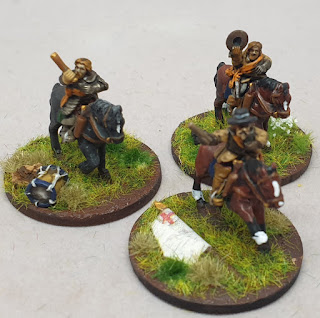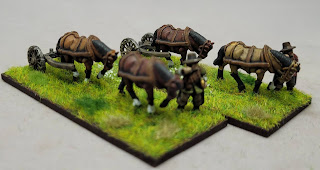Even More Parliamentarian Commanders
First up Sir William Waller, an unadulterated figure, Sir William has a spare regiment of foot flag on his base. Pure bunkum, as a found/captured ensign would be paraded rather than just left on the floor. Normally Maverick flags need sealing with a PVA/water mix but I didn't think I'd be able to get the close folds that I wanted. Trimmed very carefully with a new X-Acto blade I cut the flag so that I had the side I wanted and just enough to wrap around the flagstaff (a spare pike I had lying around), I superglued the flag in position, and once dry I washed the flag with a 75/25 mix of PVA and water, left it to dry for a few minutes then made the folds. Frequent adjustment was required whilst it dried, then any loose strands of fabric were trimmed once it was thoroughly dry.
Waller's history is entwinned with that of his good friend, and opponent Sir Ralph Hopton. The two epitomising the way in which the war wrenched the country apart.
Waller was born in Kent, the son of the Lieutenant of Dover Castle. William 'the conqueror' was blessed with an amazing ability to escape death by a hair's breadth on numerous occassions: as a child he survived a number of illnesses that often proved fatal, and he narrowly missed a stray shot as he lay in his cradle; during his service abroad he had his horse shot from under him and survived many direct shots, dodged the Inquisiton at Bolonia because his belongings weren't searched (which no doubt would have condemned him), and managed to avoid catching the plague in Calais despite holding the hand of Sir Philip Stapleton as he lay dying of plague; he narrowly missed being shot by one of his own men at Farnham Castle; he failed to wear his helmet at Cheriton and managed to get separated from his men, he and his three colleagues somehow managing to survive; whilst holding a council of war at Cropredy the building collapsed around him; he somehow managed to survive being one of the Eleven Members of Parliament excluded by the Army, was excluded again during Pride's Purge, and arrested under suspicion of being involved in Booth's Rebellion.
Next is Sir Arthur Hesilrigge, wearing full armour as at Roundway Down a fully armoured Haselrigge was repeatedly assailed by Captain Richard Atkyns – Atkyns discharged his pistols when he felt their barrels touch his opponents armour, "he was too well armed all over for a pistol bullet to do him any harm".
Sir Arthur held radical political and religious views and was an outspoken critic of King Charles' Personal Rule. He was brought before the Court of High Commission several times for non-payment of fees and taxes and was briefly imprisoned in the Tower of London. He would play a leading role in the impeachment of Lord Strafford.In 1643 his troop suffered heavy losses at Ripple Field, he returned to London where he raised a new regiment of horse his famous lobsters. He would resign his commission as a consequence of the Self Denying Ordinance.
Lord Saye and Sele completes the trio, the ECWTravelogue visited his home Broughton Castle last summer, the Castle became a meeting place for dissidents where opposition to the King's policies was orchestrated prior to the outbreak of open warfare. William Fiennes was the 8th Viscount Saye and Sele, nicknamed 'Old Subtlety' by the King for his cunning political machinations. Disheartened by Charles's execution in 1649, he retired from public life. He spent much of his time during the Commonwealth and Protectorate years at his property on Lundy Island. He accepted the Restoration in 1660 and was appointed a privy councillor to King Charles II, he died at Broughton Castle in April 1662.














Hesilrige was an interesting cove, for sure...
ReplyDeleteThere certainly was an abundance of 'characters' during the Wars
DeleteLovely trio of Parliamentary commanders!
ReplyDeleteBest Iain
Thanks Iain
Delete